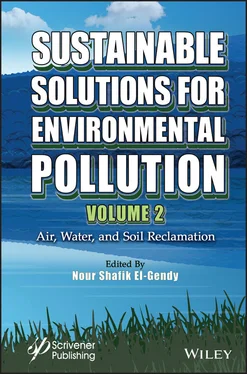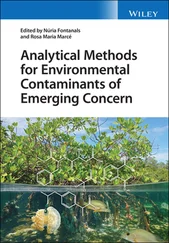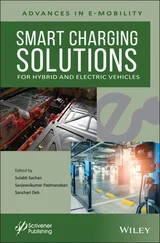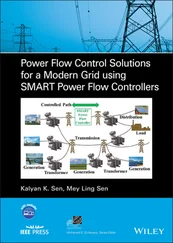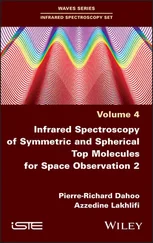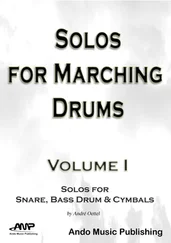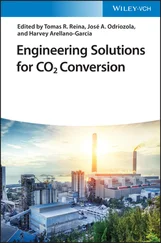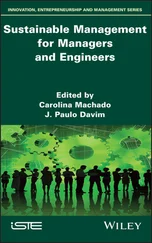Sustainable Solutions for Environmental Pollution, Volume 2
Здесь есть возможность читать онлайн «Sustainable Solutions for Environmental Pollution, Volume 2» — ознакомительный отрывок электронной книги совершенно бесплатно, а после прочтения отрывка купить полную версию. В некоторых случаях можно слушать аудио, скачать через торрент в формате fb2 и присутствует краткое содержание. Жанр: unrecognised, на английском языке. Описание произведения, (предисловие) а так же отзывы посетителей доступны на портале библиотеки ЛибКат.
- Название:Sustainable Solutions for Environmental Pollution, Volume 2
- Автор:
- Жанр:
- Год:неизвестен
- ISBN:нет данных
- Рейтинг книги:3 / 5. Голосов: 1
-
Избранное:Добавить в избранное
- Отзывы:
-
Ваша оценка:
- 60
- 1
- 2
- 3
- 4
- 5
Sustainable Solutions for Environmental Pollution, Volume 2: краткое содержание, описание и аннотация
Предлагаем к чтению аннотацию, описание, краткое содержание или предисловие (зависит от того, что написал сам автор книги «Sustainable Solutions for Environmental Pollution, Volume 2»). Если вы не нашли необходимую информацию о книге — напишите в комментариях, мы постараемся отыскать её.
This second volume in a broad, comprehensive two-volume set, “Sustainable Solutions for Environmental Pollution”, concentrates on air, water, and soil reclamation, some of the biggest challenges facing environmental engineers and scientists today.
AUDIENCE: Sustainable Solutions for Environmental Pollution,
Sustainable Solutions for Environmental Pollution, Volume 2 — читать онлайн ознакомительный отрывок
Ниже представлен текст книги, разбитый по страницам. Система сохранения места последней прочитанной страницы, позволяет с удобством читать онлайн бесплатно книгу «Sustainable Solutions for Environmental Pollution, Volume 2», без необходимости каждый раз заново искать на чём Вы остановились. Поставьте закладку, и сможете в любой момент перейти на страницу, на которой закончили чтение.
Интервал:
Закладка:
Persistent Organic Pollutants (POPs) are synthetic chemicals capable of long-range transport, persistent in the environment and with a potential to bio-magnify and accumulate in ecosystems. The most widely occurring POPs in water systems are related to agriculture runoff [pesticides], to industry [polychlorinated biphenyls (PCBs)], to urban wastewater with flame retardants and surfactants [including PFOS (Perfluoro-octanesulfonic acid)–based products, polychlorinated dibenzo-p-dioxins (PCDDs), and dibenzofurans (PCDFs), commonly known as “dioxins”], and to domestic pollutants (e.g., detergents, pharmaceuticals, and personal care products). As with all wetland techniques, the effectiveness of phyco-remediation in eliminating organic pollutants depends on a series of processes such as photo-degradation, adsorption, bioaccumulation, biodegradation, and volatilization (Gaur et al. , 2018).
1.9 Phytoremediation
A large number of aquatic plants such as water hyacinth ( Eichhornia crassipes ), water lettuce ( Pistia stratiotes L.), duckweed ( Lemna , Spirodela , Wolffia , and Wolfiella ), bulrush ( Typha ), common reed ( P. australis ), and vetiver grass ( Chrysopogon zizanioides ) are used in the elimination of contaminants and therefore have been studied by various researchers (Mkandawire and Dudel, 2007).
1.9.1 Carbon and Nutrients (N and P) Removal
Macrophyte uptake of N and P is one of the processes involved in the removal of nutrients from wastewater. Removal of N and P will depend on the growth rate of the plant, the culture density, and environmental parameters such as solar radiation and temperature (Reddy and Tucker, 1983). Results from applications involving emergent plants on domestic effluent treatment have had varying results. A study from Van De Moortel et al. (2010) on the treatment of raw domestic effluent had N (including NH 4) and P removal between 40% and 50%. This may be due to the low coverage that the vegetation had in the system (Van de Moortel et al. , 2010). Weragoda et al. (2012) applied the FT-CW principles with two aquatic plant species ( Typha angustifolia and Canna iridiflora). NH 4removal from domestic effluent varied between 50% and 85% for T. angustifolia and 58% and 81% for C. iridiflora (Weragoda et al., 2012). Total N (N tot) removal in the CW types studied by Vymazal (2007) varies between 40% and 50%, with the load removed ranging between 250 and 630 g N/(m 2yr) depending on the CW type and inflow loading. In fact, the total elimination of nitrogen pollution requires both aerobic and anaerobic conditions at the same time on contiguous areas. Single flow type CWs cannot achieve high N totremoval due to their inability to provide these conditions at the same time. Vertical flow CWs successfully remove NH 4, but their denitrification capacity is very limited. On the other hand, horizontal flow CWs provide good denitrification conditions, but their ability to nitrify ammonia is very limited. Therefore, it is necessary to combine different flow types of CWs in a hybrid system in order to exploit the specific advantages of each flow type individually and ensure maximum elimination of nitrogen pollution (Vymazal, 2007). In SSF-CWs, nutrients removal by plants is usually considered to be negligible (10% of the N load and 5% for the P load). However, in case of low inflow loadings (i.e., 200–500 g N/m 2/yr and 50–100 g P/m 2/yr, with high stands of emergent biomass, much higher removal (around 60% for N and P) can be achieved (Vymazal, 2020). A full-scale 20-year-old surface-flow CWs treating agricultural was monitored over a 2-year-long period by (Lavrnić et al., 2020b). In this well-established system, high retention was observed for TSS (82%) and N (78%), but it was rather mediocre for P (27%). This negative value became positive when the input of nutrients by rainfall was included in the mass balance.
1.9.2 Metals Removal
The plants require some heavy metals up to a certain limit (e.g., Zn, Cu, Mo, Ni, or Mn) for their growth and development but above that limit these metals become toxic to the plants and influence negatively the metabolic functions (Andresen et al. , 2013). Toxicity of heavy metals causes Reactive Oxygen Species (ROS) production, affecting physiological processes such as photosynthesis, respiration, and cell disintegration and causing even the death of the plants (Zhang et al. , 2017). Some plants have tolerant capacity toward heavy metals due to presence of anthocyanins, thiols, and anti oxidants (Leao et al. , 2014). Other like duckweeds has extraordinary efficiency to recover very fast toward high heavy metals exposure (Ekperusi et al. , 2019; Ansari et al. , 2020). Bioremediation by phytoremediation involves extracting pollutants from the polluted environment and concentrating them in plants which should be removed from the environment to be restored (Haldar and Ghosh, 2020). Through the food chain, metals and metalloids stored in plant tissues can also be consumed by aquatic organisms and accumulate in their tissues.
Heavy metal can also precipitate and be immobilized in bottom sediment: this is only apparent self-purification. It is known that bottom sediment can act as a sink for metals. However, metals precipitated in this way can be released massively again, when there is a change in pH or redox potential, as in the case of eutrophic or dystrophic waterbodies.
The higher concentrations of trace metals accumulated were recorded in the roots and leaves of common reed Phragmites communis and spiny naiad Najas marina (Baldantoni et al. , 2004). A pilot SSF-CW planted with the Mexican sword plant ( Echinodorus palaefolius ) in a zeolite substrate makes it possible to immobilize 91.8% of the Hg of an effluent highly spiked at 14.94 mg/L in three days (Prasetya et al. , 2020). It should be pointed out that wetlands are hot spots for the Hg methylation, which diminishes the interest of this phytoremediation technique for mercury pollution (Wang et al. , 2020b).
Free-floating aquatic plants develop submerged roots that capture heavy metals in the water and accumulate them in their roots, runners, and leaves (Galal et al. , 2018; Ali et al. , 2020). Free-floating aquatic plants grow relatively fast and are easy to cultivate. They have the great advantage of rapidly building up a biomass that can be easily harvested continuously, thus allowing a continuous export of accumulated pollutants out of the water body. Water hyacinth ( Eichhornia crassipes ) has been identified to be quite efficient in the removal of heavy metals from AMD (Mang and Ntushelo, 2019). E. crassipes exhibits high metal bioconcentration factors (Mn = 199,567 > Pb = 19,605 > Cd = 3403 > Zn = 1913). The translocation factor is less than 1, suggesting a weak ability to transfer metals from roots to runners and leaves. The roots accumulate more Pb, Zn, Cd, and Mn than runners and leaves because of stronger metal tolerance of roots (Jamuna and Noorjahan, 2009). Water lettuce ( Pistia stratiotes ) has the ability to accumulate high concentrations of Pb, Cu, Cr, Ni, and Co in its roots and leaves. The bioconcentration factor of investigated heavy metals is greater than 1,000, except for Cr (65) and Pb (241), while the translocation factor does not exceed one, except for Pb (1.3) and Cu (37.8). Its roots are bioaccumulators of Cu, Ni, and Co (Galal et al. , 2018).
Evaluation of the synergy of Pb and Cr(VI) on their simultaneous accumulation in the watercress ( Nasturtium officinale ) in CWs shows a cumulative accumulation in stems, leaves, and roots. The highest concentration of both metals occurs in the roots (Pb> Cr). The higher the concentration of Cr(VI) ions, the more metal the N. officinale absorbs, the higher the metal tolerance index and the lower the translocation factor. In the CW, removal rates were >99.9% (100 mg/L) for Pb and 95% (28.5 mg/L) for Cr (Marquez-Reyes et al. , 2020).
Читать дальшеИнтервал:
Закладка:
Похожие книги на «Sustainable Solutions for Environmental Pollution, Volume 2»
Представляем Вашему вниманию похожие книги на «Sustainable Solutions for Environmental Pollution, Volume 2» списком для выбора. Мы отобрали схожую по названию и смыслу литературу в надежде предоставить читателям больше вариантов отыскать новые, интересные, ещё непрочитанные произведения.
Обсуждение, отзывы о книге «Sustainable Solutions for Environmental Pollution, Volume 2» и просто собственные мнения читателей. Оставьте ваши комментарии, напишите, что Вы думаете о произведении, его смысле или главных героях. Укажите что конкретно понравилось, а что нет, и почему Вы так считаете.
